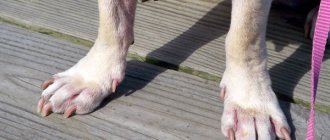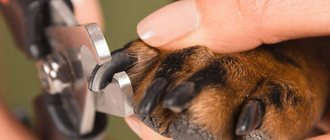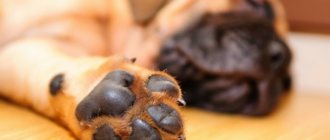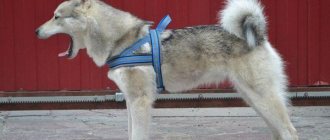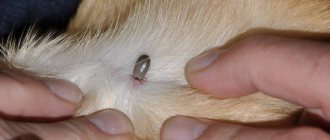Dogs need to have their nails trimmed regularly, as excessively long nails cause discomfort for the pet, deterioration of its gait, and incorrect paw positioning, which can lead to overload of the joints and even dislocation of the toes.
It is not advisable to use simple or manicure scissors and tweezers for cutting.
The structure of dog claws is different from human claws, so they can split and break off. For this purpose, you should choose special nail clippers. They come in several shapes and sizes to suit dogs of different sizes.
Price for cutting nails for dogs
| Name of veterinary services | Unit | Price, rub |
| ⭐ Nail trimming | 1 animal | 300 |
| ⭐ Beak trimming | 1 animal | 300 |
| ⭐ Cleaning the anal glands | 1 animal | 300 |
| Hygienic cat grooming (with removal of mats) | 1 animal | 1200 |
| Sanitary animal grooming: | ||
| – small animals (up to 5 kg) | 1 animal | 1500 |
| – medium animals (over 5 kg to 15 kg) | 1 animal | 2500 |
| - large animals | 1 animal | 4000 |
CLINIC REGISTRATION
HOME CALL
The need for nail trimming
If a dog owner does not take care of the healthy condition of his pet’s paws and claws, the animal may develop an ailment such as ingrown claws. Unfortunately, this causes severe discomfort and pain to the pet, wounds are formed and pathways for infections are opened. Because of these pains, the dog begins to limp and use its paw fully to avoid painful sensations. Ultimately, over time, this behavior can lead to changes in skeletal structure.
Take care of your pet's health and get into the good habit of keeping your dog's paws in order. You can do this yourself or entrust the animal to the experienced veterinarians of our clinic.
Have you started to notice the clicking sound of your pet's claws? It's time to make an appointment with your veterinarian to have your dog's nails trimmed. The specialist will examine the pet, perform the procedure and advise you on caring for the animal. Remember that every dog is unique, and not everyone is suitable only for general rules and recommendations. Veterinarians at our clinic are ready to provide a wide range of services from preventive and nursing care to treatment of pets for complex diseases and surgical intervention.
Proper trimming of dog's nails
- Take the paw with your hand and lightly press on the pad until the entire length of the claw appears.
- Look carefully at where the vascular matrix ends and the stratum corneum begins.
- Step back about 2 millimeters from the vessels and cut off the excess part with a nail clipper. If a vessel is suddenly touched, it is necessary to treat it with an antiseptic, for example, Chlorhexidine or Hydrogen Peroxide.
If you are afraid that you won’t be able to cope, or the dog breaks out and behaves restlessly, or the animal’s claws are dark, which makes it impossible to determine where the blood vessels end, you should entrust the haircutting procedure to a professional groomer. He will carefully cut the claws and tell you how to care for them. When grooming animals that behave anxiously or try to bite, muzzles, various blankets or collars are used. In extremely rare cases, excessively aggressive behavior may require sedation.
The Bio-Vet veterinary clinic employs qualified specialists who have extensive practical experience. With us, your beloved pet will always be healthy and happy! The clinic's branches are located in all districts of Moscow, in Reutov and Lyubertsy.
When should you cut your dog's nails?
It's easy to tell if your claws are long enough. Place the dog on a hard, flat surface, and if the nails touch it, then it’s time to do a “manicure.”
When carrying out this procedure, it is important to use special devices, so-called nail clippers, since ordinary scissors can damage the claw: break it off and delaminate it.
Dogs need to have their nails trimmed regularly, but your veterinarian will help you determine the proper frequency based on several factors:
- Breed, weight and age of the pet;
- Individual characteristics of the animal: paw structure, previous injuries, etc.;
- Level of physical activity and dietary features;
- Coverings of usual locations for walking: lawn or asphalt.
There are also general recommendations: for dogs of large breeds, correct the length of their claws once every 2-3 months, for small pets – once every month or two.
How often should you cut your hair?
Check your pet's paws regularly. In dogs of small decorative breeds, the claws grow very quickly: their weight is small, and there are practically no active walks, so natural grinding practically does not occur. Small breed dogs need their nails trimmed once every one to two weeks. For other dogs - on average once a month or less, depending on activity. In any case, carefully monitor your pet: if his gait has changed, he has started clicking on the floor and gnawing his claws - it’s time to carry out the procedure.
Particular attention should be paid to dogs with long hair: because of it, you may not notice that it is time to trim their nails. Don't forget to trim the fur between your pet's toes and near the claws.
Subscribe to our newsletter and get a free veterinary consultation
Thanks for subscribing!
Anatomy of a dog's claws
In descriptions of dog breeds, more specifically, in a detailed examination of the structure of the paws, the shape of the claws is usually indicated. If we combine all the characteristics, we get three types of claws:
- Cat - folded with a curved tip.
- Bent - arched.
- Hare - straight, long and most often sharp.
The first two types are characteristic of service breeds, the third - decorative and the terrier group. Claws are a full-fledged part of the paw that performs certain functions. The first thing that comes to mind: a dog digs with the help of its claws, but besides the obvious... claws affect posture, balance and the quality of traction with the ground when walking and running.
Let's say you decide not to trim your dog's nails, what are the consequences? If your ward is active and gets enough exercise - minimal, but for decorative breeds - catastrophic. So, trimming nails warns:
- Problems with the musculoskeletal system - too long claws rest on the floor or asphalt, which is why the fingers are constantly in an unnatural position. When the claws grow and become a little longer, every step the dog takes will be painful and he will deliberately begin to clubfoot. Shifting centers of gravity will lead to deformation of the joints...at the beginning of the paws, and later the spine.
- Severe injuries - everyone knows that most purebred dogs have four toes on their hind legs and five on their front legs. In outbred quadrupeds, the dewclaws on the hind legs are not removed or condemned. The fifth toes are located above ground level, on the inner side of the paw, that is, they do not wear out when walking and are constantly growing. As a result, a long and curved claw can catch on a bush or bedspread, which will lead to a tear in the soft tissue.
- Loss of balance while running - short claws provide additional support during movement, and long claws twist the fingers.
- Minor inconveniences - a pet that gets up to drink some water on a quiet night will not go unnoticed, since its “manicure” will click quite loudly on the floor covering.
Important! Grooming your dog requires trimming its nails!
Nail trimming tools
Horrified by the length of your pet's claws, have you already grabbed regular scissors? Firstly, stop, and secondly, do not remove the scissors too far if your pet has long hair. A dog's claws are much thicker and stronger than a human's, so put the pliers aside as well. Special tools have been developed for caring for dogs - nail clippers. However, even here everything is not so simple; the tool must be of high quality and correctly selected:
- First of all, you are interested in the material from which the nail clippers are made - at least steel, preferably brass (the harder the metal, the slower the blades become dull). The structure must be cast and riveted.
- The second thing you should pay attention to is the coating of the blades and the shape of the handles. The metal can be chrome treated (preferred) or untreated (some metals will rust).
- The handles should fit comfortably in the palm and be rubberized. Mild diaper rash will cause the smooth plastic handles to slip and slide, and to properly trim your dog's nails, you need to be sure of every movement.
- The accessory must match the breed (size) of the dog. Usually, on the counter of a pet store there are nail clippers for small, medium and large dogs. There are universal products that are suitable for dogs of any size and even cats.
A large number of colorful packaging can confuse you when choosing a tool. In addition, you will need a nail file to process already trimmed nails. Remember, there are only 2 types of nail clippers:
- Scissors - similar to pruning shears, there are 2 handles and 2 blades, one straight, the other curved into a hook.
- Guillotine shears are a design with a hole for a claw and a lever handle.
- Files - usually available in a wide range of models, have a hard coating and are graded according to the size of the dog and the hardness of the claws.
It is worth mentioning electric (battery or mains powered) scratching posts. The tool is a “base”, at the top of which there is a rod for the attachment. The attachment is a grinding stone. With the help of the accessory, you can grind the claws to the desired length and shape without resorting to cutting. There are also disadvantages - price (for the tool itself and spare parts), noise and heating of the claw from friction. In short, not every dog will appreciate the modernity and convenience of the new technology.
Nail trimming - step-by-step theory
You have chosen the right time, processed and prepared the instruments, fastened the dog on a leash and are ready for the procedure. Where to start? Pet your pet, tease him a little with a toy and make sure the dog is in a good mood. While you are entertaining your pet, mentally prepare for the fact that you may not complete the procedure, for example, trim only 2-3 nails. Have a positive and confident attitude, the ward should feel that he is safe. Next, let's start cutting:
- Start with the front paws. Give the command “Give me a paw” and generously praise your pet for following through. It is recommended to cut the claws of the hind paws not immediately, but after a break of 2-3 hours.
- Inspect your fingers and remove excess hair. Again, praise your pet for his patience.
- Take nail clippers and let your dog sniff them.
- Place the nail clipper blades 1.5 mm below the pulp, at a 45° angle, and cut. It can take a long time to set up, but you need to trim your nail quickly and confidently.
- Everything went well? Praise your dog as if he just conquered Olympus! Feed him treats and be sure to take a 2-3 minute break.
- Finish the cuts with a nail file. This is optional, but doing it will help dull the sharp edge of the claw.
- The hind legs will be a little more difficult. During grooming, the pet should lie on its side. Over time, when the procedure does not cause anxiety in the dog, the claws of the hind legs can be trimmed in a standing position.
Important! Stop the procedure as soon as the dog begins to get nervous and struggle. Even one trimmed claw during the first procedure is a result that should be supported by positive emotions, not fear.
Why do dogs need to have their nails trimmed?
The structure of claws is not the same in all dog breeds. There are 3 main types of claw processes in dogs based on the type of growth:
- folded with an arched shape;
- hare (characterized by sharp tips and straight shape);
- bent like a cat's, having curved ends.
Curved with an arched shape and curved like a cat's, they are characteristic of working breeds of dogs. Hare claws are characteristic of dwarf and decorative indoor dogs.
The frequency of nail trimming depends on individual characteristics. If nail trimming is done untimely and sometimes incorrectly, a number of problems arise. The pet may suffer from problems with walking, the center of gravity shifts, which threatens loss of balance or even lameness.
Measure seven times - rules for trimming dog nails
Here we come to the complexities of this seemingly simple procedure. Each dog's claw has a cavity filled with a large number of blood vessels and nerve endings. That is, one wrong move will cost the pet serious stress and reluctance to resort to this procedure in the future. Remember, you probably hit your little finger on the corner of the furniture, half asleep at night... remember these sensations? Did shivers run down your spine? So multiply this by 3 and you can imagine how a dog feels if its nails are cut incorrectly. Call your pet right now and look at his claws, you will see the following:
- If the dog's nails are black, you will not see anything new and this is the most difficult case.
- On light, beige and brown nails, you will see a darkened area from the base of the nail to almost the very tip. This is the pulp, which cannot be damaged when shearing.
Important! The pulp is not visible on black claws. Try to illuminate the claw with a flashlight and if the situation does not clear up, you will have to cut it at random.
Place your pet's paw on the floor. When you trim the nails, the line of the nail clipper blades should be at a 45° angle and 1-1.5 mm below the pulp. Never shorten your nails to the desired length right away! This is guaranteed to end in injury! Yes, trimming a dog’s nails at home is difficult even in theory and only practice will help, but remember that even veterinarians make mistakes when carrying out the procedure. Be careful and take your time!
Black claws are trimmed 0.5 mm per “step”. As soon as you see that the cut has become lighter or pinker, you need to stop - the next “step” will damage the pulp. By the way, each haircut “drives” blood vessels deeper into the claw. Thus, persistence and constant frequency will help shorten your pet’s claws to the desired length without injury. Another landmark that can help is the dimple on the side of the claw (if there is one), sometimes called the bloodstream. The pulp is usually equal to or 0.5–1 mm longer than this depression.
Important! The most common and critical mistake is rough handling of the dog. You get ready, cook with your pet sharply, squeeze your paw, and beads of sweat appear on your face. The picture that appears before the pet evokes a premonition of “a life-and-death slaughter.” In addition, practice shows that a person makes many more mistakes when he is worried.
First aid for injuries
Many dogs become very nervous before their nails are trimmed, even if they have not experienced negative emotions before. One alternative is sedatives. Usually, sedatives are made from herbs and dull nervous excitability, this is exactly the effect that is needed for the procedure. Next, prepare special powder or wipes with a hemostatic effect. If you cut the claw too deep, dozens of blood vessels will be damaged. Typically, injuries are accompanied by severe bleeding, which causes mutual panic between the owner and the dog.
Important! Under no circumstances should you treat a damaged claw with brilliant green, fucorcin, iodine, alcohol, dimexide, peroxide, alcohol, vodka, etc. If you don’t have special powder on hand, regular food flour will do. Any alcohol-containing or cauterizing solutions will only increase the pain!
Another rather complex injury is a claw tear. This usually happens if you squeeze the nail clippers slowly and the dog jerks his paw hard. The fixed claw remains in the forceps, and the skin and soft tissues are torn. The first thing you need to realize is that it hurts a lot! Be prepared for the dog to whine a lot and try to run away. Act quickly and without panic:
- Continuously talk to the dog, calm it down, do everything to distract it.
- Use a piece of gauze to grab the injured paw at the wrist (metatarsus).
- Tighten and secure the gauze well, it is advisable to raise the limb as high as possible.
- Apply cold to the injured paw - ice, frozen vegetables or a piece of minced meat from the freezer. First, wrap the compress in a cotton towel and cellophane. The cold will help stop the bleeding and relieve some of the pain.
- Examine the wound, if there are open tears, fill them with lidocaine or novocaine.
- If the wound looks too large and requires stitching, wrap the paw in a clean towel, apply ice and go to the vet without delay.
- For small breaks, the wound should be treated with a healing ointment with an anesthetic effect and bandaged. The bandage is applied only after the bleeding has completely stopped. It is also recommended to apply a separate, small piece of gauze to the wound, folded 4-6 times (it will stick to the drying wound).
Important! Damage to the claw means stopping the procedure. File any remaining nails or leave the dog alone for 5-7 days.
